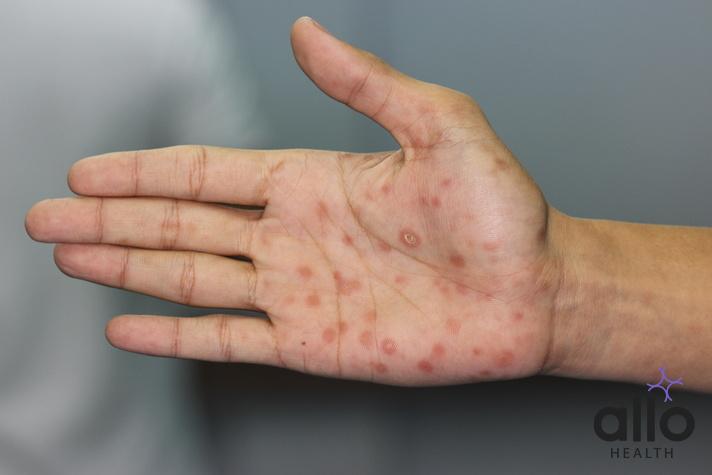What Are The Symptoms And Complications Of Syphilis?

Allo Health is dedicated to personalized well-being, offering support and trusted information tailored to individual health goals. The platform emphasizes human-generated content, led by a distinguished medical team of experts, including physicians and sexual health specialists. Their commitment to credibility involves rigorous fact-checking, authoritative research, and continuous updates to ensure accurate, up-to-date information. Allo Health's unique approach goes beyond conventional platforms, providing expert-led insights and a continuous commitment to excellence, with user feedback playing a crucial role in shaping the platform's authoritative voice.

Dr. Aditi completed her undergraduate medical education at AJIMS, Mangalore, after which she worked in multi-speciality hospitals with COVID patients and in the Pain and Palliative medicine department. Driven by her experiences, she developed a keen interest in psychiatry. Dr. Aditi believes that mental health is just as, if not more important, than physical health.
Why This Was Upated?
Our experts continually monitor the health and wellness space, and we update our articles when new information became available.
Updated on 26 February, 2025
- Article was updated as part of our commitment to diversity, equity, and inclusion.
"The following blog article provides general information and insights on various topics. However, it is important to note that the information presented is not intended as professional advice in any specific field or area. The content of this blog is for general educational and informational purposes only.
Book consultation
The content should not be interpreted as endorsement, recommendation, or guarantee of any product, service, or information mentioned. Readers are solely responsible for the decisions and actions they take based on the information provided in this blog. It is essential to exercise individual judgment, critical thinking, and personal responsibility when applying or implementing any information or suggestions discussed in the blog."
Syphilis is a sexually transmitted infection (STI) caused by the bacterium Treponema pallidum. It progresses in stages, each characterized by distinct symptoms and complications if left untreated. Understanding these stages and associated manifestations is crucial for timely diagnosis and management. Here’s an overview of the symptoms and complications of syphilis.
Primary Stage
The primary stage begins with the appearance of a painless sore, known as a chancre, at the site of infection. This sore typically develops around three weeks after exposure to the bacterium. Common locations for chancres include the genitals, anus, rectum, or mouth. However, they can also occur on other parts of the body that come into contact with infected fluids.

- Chancre Characteristics: Chancres are usually firm, round, and painless. They may go unnoticed due to their painless nature, leading to delayed diagnosis and treatment.
- Duration: Chancres can persist for 3 to 6 weeks and heal spontaneously even without treatment. However, the infection remains in the body and progresses to the next stage if not treated.
Secondary Stage
If syphilis is left untreated, it progresses to the secondary stage, which is characterized by systemic manifestations as the bacterium spreads throughout the body. Symptoms typically appear weeks to months after the primary chancre heals.
Common symptoms include:
- Skin Rash: A non-itchy rash may develop on the trunk, palms, and soles of the feet. The rash can vary in appearance, ranging from small, reddish-brown spots to larger, raised lesions.
- Mucous Membrane Lesions: Syphilis can cause lesions in the mouth, throat, and genital areas. These lesions are often painless but can be highly infectious.
- Flu-like symptoms: Patients may experience fever, fatigue, headache, muscle aches, and swollen lymph nodes.
- Hair Loss: Patchy hair loss, particularly in the eyebrows, is another characteristic feature of secondary syphilis.
- Genital Warts: In some cases, syphilis can mimic genital warts or other STIs, leading to misdiagnosis.
Latent Stage
After the secondary stage, syphilis enters a latent stage where symptoms are not present but the infection remains in the body. There are two types of latent syphilis:
- Early Latent Syphilis: This phase occurs within the first year after initial infection. Although no symptoms are present, the bacterium is still active in the body and can be transmitted to others.
- Late Latent Syphilis: If untreated, syphilis enters a late latent stage where the infection persists for years without causing symptoms. However, complications can still arise during this phase.
Tertiary Stage and Complications

Without proper treatment, syphilis can progress to the tertiary stage, which is characterized by severe and potentially life-threatening complications. Tertiary syphilis can occur years or even decades after the initial infection.
Common complications include:
- Neurosyphilis: This condition affects the nervous system and can lead to a range of neurological symptoms such as headaches, dizziness, vision problems, stroke, and cognitive impairment.
- Cardiovascular Syphilis: Syphilis can damage the cardiovascular system, leading to aortic aneurysms, aortic insufficiency (leaky heart valve), and inflammation of the heart’s lining (endocarditis).
- Gummatous Syphilis: Gummas are soft, tumor-like growths that can develop on various organs, including the skin, bones, liver, and brain. They can cause significant tissue damage and organ dysfunction.
- Congenital Syphilis: Pregnant women with untreated syphilis can transmit the infection to their babies, leading to congenital syphilis. This can result in serious complications such as stillbirth, prematurity, low birth weight, developmental delays, and organ damage in newborns.
Complications Of Syphilis
Syphilis starts affecting organs like the heart, brain, nerves, and bones. Neurosyphilis can lead to paralysis, dementia, and sensory deficits. Cardiovascular syphilis can result in aneurysms and heart valve damage. Late-stage syphilis can cause destructive gummas in tissues, leading to deformities. Congenital syphilis passed from mother to child, can cause stillbirth, developmental issues, and organ damage. Early detection and treatment are crucial to prevent these complications.
Diagnosis and Treatment
Diagnosing syphilis typically involves a combination of medical history review, physical examination, laboratory tests (such as blood tests for syphilis antibodies), and sometimes imaging studies to evaluate for complications like neurosyphilis. Early diagnosis is crucial to prevent the progression of the infection and reduce the risk of complications.
Treatment for syphilis usually involves antibiotics, primarily penicillin. The type and duration of antibiotic therapy depend on the stage of the infection and any associated complications. Sexual partners of infected individuals need to undergo testing and receive treatment if necessary to prevent further transmission.
Syphilis is a complex STI that progresses through distinct stages, each with its set of symptoms and potential complications. Prompt diagnosis and appropriate treatment are essential to prevent the progression of the infection and mitigate the risk of serious complications. Regular STI testing, practicing safe sex, and seeking medical advice if symptoms arise are key strategies in managing syphilis and promoting sexual health.








































